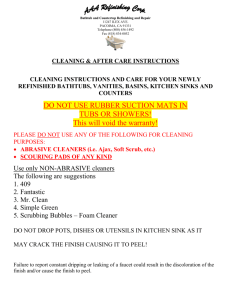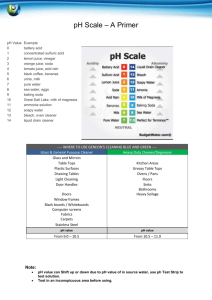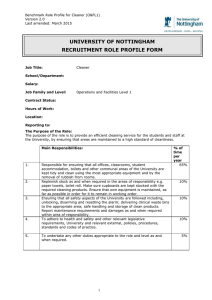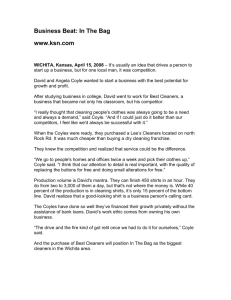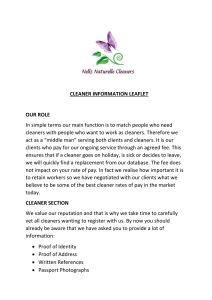cleaning for heat - ASM International
advertisement
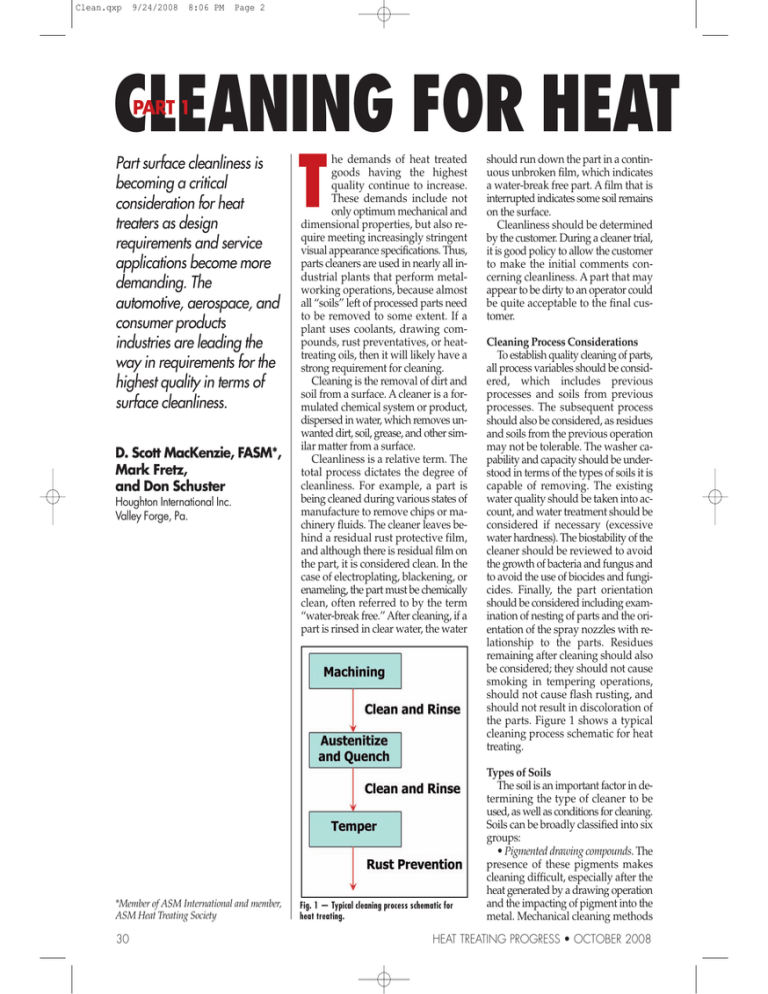
Clean.qxp 9/24/2008 8:06 PM Page 2 CLEANING FOR HEAT PART 1 Part surface cleanliness is becoming a critical consideration for heat treaters as design requirements and service applications become more demanding. The automotive, aerospace, and consumer products industries are leading the way in requirements for the highest quality in terms of surface cleanliness. D. Scott MacKenzie, FASM*, Mark Fretz, and Don Schuster Houghton International Inc. Valley Forge, Pa. *Member of ASM International and member, ASM Heat Treating Society 30 T he demands of heat treated goods having the highest quality continue to increase. These demands include not only optimum mechanical and dimensional properties, but also require meeting increasingly stringent visual appearance specifications. Thus, parts cleaners are used in nearly all industrial plants that perform metalworking operations, because almost all “soils” left of processed parts need to be removed to some extent. If a plant uses coolants, drawing compounds, rust preventatives, or heattreating oils, then it will likely have a strong requirement for cleaning. Cleaning is the removal of dirt and soil from a surface. A cleaner is a formulated chemical system or product, dispersed in water, which removes unwanted dirt, soil, grease, and other similar matter from a surface. Cleanliness is a relative term. The total process dictates the degree of cleanliness. For example, a part is being cleaned during various states of manufacture to remove chips or machinery fluids. The cleaner leaves behind a residual rust protective film, and although there is residual film on the part, it is considered clean. In the case of electroplating, blackening, or enameling, the part must be chemically clean, often referred to by the term “water-break free.” After cleaning, if a part is rinsed in clear water, the water Fig. 1 — Typical cleaning process schematic for heat treating. should run down the part in a continuous unbroken film, which indicates a water-break free part. A film that is interrupted indicates some soil remains on the surface. Cleanliness should be determined by the customer. During a cleaner trial, it is good policy to allow the customer to make the initial comments concerning cleanliness. A part that may appear to be dirty to an operator could be quite acceptable to the final customer. Cleaning Process Considerations To establish quality cleaning of parts, all process variables should be considered, which includes previous processes and soils from previous processes. The subsequent process should also be considered, as residues and soils from the previous operation may not be tolerable. The washer capability and capacity should be understood in terms of the types of soils it is capable of removing. The existing water quality should be taken into account, and water treatment should be considered if necessary (excessive water hardness). The biostability of the cleaner should be reviewed to avoid the growth of bacteria and fungus and to avoid the use of biocides and fungicides. Finally, the part orientation should be considered including examination of nesting of parts and the orientation of the spray nozzles with relationship to the parts. Residues remaining after cleaning should also be considered; they should not cause smoking in tempering operations, should not cause flash rusting, and should not result in discoloration of the parts. Figure 1 shows a typical cleaning process schematic for heat treating. Types of Soils The soil is an important factor in determining the type of cleaner to be used, as well as conditions for cleaning. Soils can be broadly classified into six groups: • Pigmented drawing compounds. The presence of these pigments makes cleaning difficult, especially after the heat generated by a drawing operation and the impacting of pigment into the metal. Mechanical cleaning methods HEAT TREATING PROGRESS • OCTOBER 2008 Clean.qxp 9/24/2008 8:07 PM Page 3 TREATING such as ultrasonic, electrolytic, and spray cleaning aid in the removal of such compounds. • Un-pigmented drawing compounds, oils, and greases. Hot alkaline cleaning normally removes such soils. lf high viscosities are encountered, precleaning in a solvent or solvent emulsion cleaner will dissolve some soil and lower the viscosity, thus enabling the alkaline cleaner to perform more efficiently. • Machining lubricants. Soluble oils and synthetic and emulsion cutting fluids are readily removable using synthetic and alkaline cleaners. The presence of sulfur and chlorine components may make the soil more difficult to remove using alkaline cleaners, and solvents or emulsions are sometimes necessary. The presence of fatty acids in the cutting fluids promotes better cleaning through reaction with the alkaline cleaner. • Polishing and buffing compounds. Buffing compounds in general are difficult to remove because of the heat generated during the buffing operation. Aging and over-buffing should be avoided. Aging causes polymerization, and over-buffing leaves excessive amounts of compounds on the workpiece. Products containing high degrees of detergency and solvency are normally recommended. • Carbonaceous soils. Dry, finely divided carbon particles are some of the more difficult soils to remove. Direct agitation, such as high pressure spray impingement, sometimes removes such soils. An emulsion cleaner is often effective as is ultrasonic cleaning. • Rust, scale, and paint. Removal of these soils is considered a specialty area. High caustic alkaline cleaners may be used for removal of light rust, paint, lacquer, etc. Heavy scale must be removed using acids. Paint removal from aluminum and zinc metals must be accomplished using a paint stripper. Besides the type of soil considered above, there are additional soil variables that should be considered to determine the proper method of cleaning including: • Physical form of the soil. This includes the viscosity of the liquid and the melting point of any solids. • Fine particulate. The presence of Fig. 2 — Dried yellow solid material on a “cleaned” part after heat treating resulting from silicated cleaner residue remaining on the part before heat treating. finely divided particles can make soil removal very difficult to remove. • Corrosion or oxidation products in the soil. Proper neutralization of these soils is important so damage will not occur to the part. Cleaners work by both a chemical action and a physical action. The chemical actions are reaction, dissolving, emulsification, and wetting. Some soils are removed by reacting with the cleaner involved. For example, alkaline cleaners will react with fatty soils to form soaps, and these soaps aid the cleaning process. Other soils are water soluble and will be removed by being dissolved in the cleaner. An emulsifying cleaner works by dissolving oils and greases and forming a milky white emulsion. A wetting agent, or surfactant, a key ingredient in a cleaner solution, functions by lowering surface tension, thus allowing cleaner solution to penetrate between the soil and the surface. The physical actions are impingement and agitation. Impingement is involved in spray cleaning processes. The part is hit by a cleaning solution flowing through a series of spray nozzles at rather high pressures. This scrubbing action is critical to the removal of soil from the surface. Agitation is found where soak cleaning is used. A soak cleaner depends solely on detergency for removal of soil. Thus, agitation in the form of air or steam being bubbled through the solution is extremely helpful in soil removal. HEAT TREATING PROGRESS • OCTOBER 2008 Fig. 3 — Discoloration (chemical burn marks) on “cleaned” part after tempering resulting from residue remaining on the part from a highly contaminated cleaning solution. In many cases, it is necessary to remove soils after one metalworking operation and prior to another. An example would be if a part was processed through a grinding process and was scheduled to go into heat treating. After grinding, the part would have grinding fluid and metal fines on the surface, which would cause problems in the subsequent heat treat process. Therefore, an in-process cleaner would be used. A finish cleaning operation is a process where the part goes through a complete cycle such as painting, plating, enameling, anodizing, etc. Cleaning is of the utmost importance for these operations. The part must have a water-break free surface prior to the application of a coating. Rehabilitation cleaning is the cleaning of parts so they can be put back in service. Removal of rust, paint, 31 Clean.qxp 9/24/2008 8:07 PM Page 4 and grease are examples of the soils being removed. A typical application is the cleaning of gas and diesel engines. Fig. 4 — White residue (carbonate) on heat treated bolt threads resulting from high carbonate concentration in the rinse tank dragged out on the part prior to heat treating. Fig. 5 — Caustic burn on heat treated part resulting essentially from caustic cleaner and/ or chlorinated material and/or calcium compounds burned into the steel during the heat treating process. Fig. 6 — Rust on inside of induction hardened part resulting from a alkaline cleaner residue prior to hardening. 32 Typical Cleaning Problems Cleaning problems usually manifest themselves after the tempering operation. Typical problems are rinse stages being contaminated, poor cleaning due to nesting of parts, alkaline residues from poorly rinsed parts, rust and caustic burns, and excessive staining from abused quench oils. Rinse stage contaminated. After a recent shutdown, parts from a furnace were showing evidence of a dried yellow solid material on the “cleaned” part Fig. 2. The parts are heat treated, quenched, and then cleaned and rinsed. The cleaner used was a silicated cleaner, and the machining is being done using a chlorinated oil that is made up on site from spend hydraulic fluid. The dried yellow material was scraped out of the grooves and analyzed via KBr pellet-FTIR. It was identified as probable inorganic silicate and iron oxide. Because the parts were rinsed after the cleaning operation, it was believed that the rinse station had an excessive concentration of silicated cleaner from the cleaning cycle. Poor cleaning due to nesting of parts. After the tempering operation, parts were found to be discolored (Fig. 3). The discoloration matched the outlines of adjacent parts. The “cleaned” part was rinsed using ethyl ether, which was then evaporated. An oily residue remained. Fourier transform infrared spectroscopy (FTIR) showed it is an ester (possible vegetable oil) with an apparent high chlorine level. The cleaned part shows that the rinse stage must be highly contaminated with cleaner, and also with oil. This dries on the part, and at heat-treating temperatures, fuses and leaves chemical burn marks as shown Fig. 3. The solids from the quench oil were collected and were found to contain 7% Fe, 2% Ni, 2% Cr, 1% Na, 1% Al, 2% Si, 3% S, 10% Ca. This is similar to previously analyzed sludge samples, and confirms that parts are not clean, and are leaving swarf and “cooked” cleaner residue in the quenching oil. The oil portion was analyzed via FTIR and identified as a mixture of mineral oil and ester (estimated 10%). The ester could be due to hydraulic fluid contamination. FTIR analysis of quenching oil from the furnace shows a slightly elevated level of oxidation in the quench oil, but it was probably insignificant. This appears to be a cleaning related issue, rather than a quenching oil problem. Alkaline residue. A bolt manufacturer had a series of customer rejects for white residue in the threads. The white material (Fig. 4) was analyzed via reflectance FTIR and identified as primarily carbonate residue. Investigation of the rinse tank found that high carbonate concentrations were present, which is drag-out from the cleaner operation. The customer was instructed to dump the rinse tank, and to check the alkaline levels in the rinse tank on a regular basis. Caustic burns. A customer manufacturing bolts had a series of rejections from his customer for rusted and oxidized parts (Fig. 5). A package containing various sizes was submitted to the Houghton Cleaning Laboratory for evaluation. Each bolt had an uniform, even black oily finish (from the rust preventative), but there were round orange areas visible. In addition, round areas that were bluish in color were observed. The incoming bar stock is coated with calcium stearate (to aid in cold heading and threading). Parts are cold headed using chlorinated lube, washed with caustic cleaner, then go directly to heat treating (no rinse), quenched in a cold quench oil, washed in an alkaline cleaner, blow-off (no rinse), tempered at up to 1100°F, and then dipped (hot) into an aqueous rust preventative, which flashes off the water. The red spots are then observed. After degreasing using ether in the laboratory to remove the rust preventative, the bolt was noticeably covered with round spots, and several red areas as described by the customer. The spots are caused by a condition known as “caustic burn.” Essentially, caustic cleaner and/or chlorinated material and/or calcium compounds are burned into the steel during the heat treating process, leaving spotty alkaline areas on the surface of the part. The steel is quenched in an oil base product, which does not remove the caustic material because it is burned onto the surface of the part from the high temperatures during austenitizing. The parts probably are further impacted in the tempering furnace (although the damage is already present). Recommendations to the customer were to thoroughly wash and rinse the part prior to heat treatment to eliminate any caustic residues that would cause caustic burns on the part. HEAT TREATING PROGRESS • OCTOBER 2008 Clean.qxp 9/24/2008 8:07 PM Page 5 Inadequate rinsing. A customer was having rust issues on one of their induction hardeners, on one machine only (Fig.6). A polymer quenchant is used, and delivered to the machines from a 14,000-gal central system. All machines use the same quenchant. The rust is always on the inside of the part. Parts are formed using zinc stearate, machined using synthetic coolant, and cleaned using alkaline cleaner and rinsed prior to induction hardening. The inside of the part was rinsed using a small amount of distilled water. Phenolphthalein was added to this, and it turned a deep red color. The rusted area was rubbed onto a piece of Whatman ashless filter paper, which was placed into the energy dispersive X-ray fluorescence spectrometer (EDXRF) and analyzed for elemental content. In addition to the iron oxide, large amounts of sodium, potassium, and sulfur were detected. The inside of the part was coated with alkaline cleaner, probably based on potassium hydroxide and sodium sulfonate (or similar chemistry). This caused subsequent rusting. It was recommended to investigate the rinse stage on the discrepant induction hardener, and deter- Fig. 7 — Baked-on quench oil due to contaminated and oxidized quenchant. mine if either rinse nozzles were clogged, or the rinse had excessive contamination. More frequent dumping of the rinse station was also recommended. Excessive staining. A customer was experiencing severe black streaks on parts coming out of several furnaces, immediately after quenching, and prior to the quench washer (Fig. 7). As a test, parts were hand cleaned in organic solvents and inorganic cleaners prior to heat treatment. The quenched parts still had the streaking on their surface, even after thorough cleaning before heat treatment. The part shown ASM Heat Treating Society furnace donation fires enthusiasm for high school student. How can we thank you enough for being so generous to our Materials Science and Engineering class here at Westerville South High School? This is definitely Christmas in April. All year, we’ve wished that we could have a furnace just like this one and now you have made our dreams come true!” This is a story about an anonymous Founding Member of the ASM Heat Treating Society who saw an opportunity to reach out to young people with a message that “Materials are cool.” Or its corollary that “Heat treating is hot!” “We put your beautiful furnace to work immediately as our MSE class was working on their raku ceramics. All of the glazes we used contained various metal oxides which reduced to their metals on the surface of the clay.” A small heat treating furnace had been obtained to support the efforts of the ASM Materials Education Society and our Materials Camp and Teachers Camp programs in central Ohio. It was meant to be portable so that it could be lent out to teachers at different schools. But the furnace was too large to be moved and shipped cost effectively. It would have to remain in one place. “With your furnace, we can also work with creating our own design with Nitinol, do a study of the solid phase changes for a Zn-Al alloy, and make our own glass.” Rather than send the furnace back to its manufacturer, an HTS Founding Member had an idea. “I could write a check to cover the furnace and we would donate it to Westerville South High,” he thought. “Then we could buy another smaller unit that could be used by teachers at other schools.” A few phone calls were made, a check was sent and, almost immediately, the donated furnace was being used by eager students. “We are the first Materials Science and Engineering class in central Ohio, and I plan on doing everything I can to help this to spread. Our first year has been highly successful and as a result, we have at least four students who want to pursue MSE in college.” Through this initiative, an individual member of our Heat Treating Society – the proud heat treating roots of ASM – stepped up to join with the ASM Materials Education Foundation “to excite young people in materials, science, and engineering careers.” “Thank you for helping us to inspire students to pursue Materials Science and Engineering as a career. And thank you again for your generosity and for valuing the education of our young people so highly!” Very gratefully yours, Elizabeth L. Eddy Westerville South High School Teacher HEAT TREATING PROGRESS • OCTOBER 2008 www.asmfoundation.org 33 Clean.qxp 9/24/2008 8:07 PM Page 6 in Fig. 7 was collected immediately after quenching, and was hand cleaned using water and isopropanol (a total of 160 parts were cleaned in this manner). We were asked to analyze the black residue and determine corrective action. The part was wiped thoroughly using a lab wipe and isopropanol to remove any residual quenching oil. The part was then placed into an EDXRF, and the surface was analyzed for contaminants. Sulfur and calcium are present at significant levels. Following this, a piece of laboratory filter paper was dampened with isopropanol containing a small amount of acetic acid. This was vigorously rubbed on the black lacquered area and some of the black material was removed. The paper was analyzed in the same way (EDXRF). Calcium, sulfur, iron, manganese, and chromium are all prominent elements in the analysis. The presence of calcium and sulfur in the stain (after removing residual quenching oil) shows that the material is baked-on quenching oil. What is also interesting is that the staining shows the progression of the vapor phase during quenching. The mar-tempering quench oil was analyzed and found to be severely oxidized, having a excessively high Precipitation Number and Total Acid Number. Because of the extent of the oxidation, it was recommended to dump and recharge the system with fresh quench oil, and to institute proper maintenance and monitoring procedures. Types of Cleaners Many types of cleaners are available and selection of appropriate one can depend either on the type of soil or on the type of process washer used (spray, dunk, ultrasonic, etc.). The first classification of cleaners is based on chemistry. Alkaline cleaners are used for aggressive soils. Neutral cleaners are used when a rust inhibitor is required and the soil is moderate. Quench oils are generally considered to be moderate soils, unless the oil has deteriorated significantly. The use of emulsion cleaners is usually dictated by the subsequent operation. In this case, an oily film consisting of a rust preventative is left on the part. Solvent cleaners are used when it is necessary to achieve exceptionally clean parts. Unfortunately, the use of solvent cleaning is declining because of environmental considerations, while the demands for exceptionally clean parts is increasing. 34 Alkaline Cleaners Alkaline cleaners consist of a blend of alkaline salts (known as builders) and surfactants. They operate in a pH range above 7. Each salt and surfactant is added to provide specific cleaning properties within economic and other limitations. They are the most widely used cleaners due to their ability to remove a wide range of soils at low costs. The builders used in alkaline cleaner systems are hydroxides, silicates, phosphates, carbonates, borates, sulfates, and organic chelants. Hydroxides provide the highest degree of alkalinity. They are relatively inexpensive and small amounts will suffice to give the appropriate amount Cleaning is the removal of dirt and soil from a surface. A cleaner is a formulated chemical system or product, dispersed in water, which removes unwanted dirt, soil, grease, and other similar matter from a surface. Cleanliness is a relative term. The total process dictates the degree of cleanliness. of alkalinity. They increase the electrical conductivity of a cleaner, which is important for electrocleaning, and improves saponification. However, they are a poor rinser and don’t clean nonsaponifiable soils very well. A one percent solution has a pH of 1.3. Both sodium and potassium hydroxide are used in alkaline cleaners where ferrous metals are being processed. Silicates make up the largest portion of most heavy-duty alkaline cleaners. Sodium orthosilicate and sodium metasilicate are excellent emulsifiers, are good buffers at pH above 9, hold soil in suspension, and provide active alkalinity. Sodium metasilicate is the silicate most commonly used in metal cleaners. This material, when formu- lated into an alkaline cleaner, inhibits attack of the cleaner on aluminum and zinc. Silicates reduce rusting or browning of steel during electrocleaning. Alkaline cleaners compounded for general use almost always contain silicates due to their versatility. They provide a high degree of alkalinity with little or no attack on the base metal. A 1% solution has a pH of 12.3. Phosphates have a major function in metal cleaners as water softeners. They also impart alkalinity and peptize the soil, which is the breaking down of large particles to smaller ones. Carbonates serve as a low-cost source of alkalinity, as well as offer some degree of water softening. They are poor cleaners, but supply a fair amount of alkalinity. However, the major function of carbonates in metal cleaners is to aid in obtaining a free flowing, noncaking mix. Sodium carbonate, or soda ash, is by far the most widely used of the carbonates. Because of its low cost, it is used in some degree in almost all formulations. A1% solution has a pH of 11.3. Borates are used for the development of cleaners at lower pH ranges and also for rust protection. A 1% solution of 10 ml sodium tetraborate (borax) is 9.2 (pH?). Sulfates such as sodium sulfate is used as filler. However, we choose to use sodium carbonate for this purpose since it offers a greater alkalinity. Organic chelants serve to sequester magnesium and calcium ions plus various heavy metal ions. They are used as replacements for complex phosphates in low to medium alkaline pH ranges. These products find applications in areas of the country where phosphates are not permitted. As mentioned previously, builders and surfactants comprise the composition of alkaline cleaners. Builders alone will not clean satisfactorily. They need to be combined with a surfactant to perform efficiently. A surfactant has the property of concentrating at surfaces because it contains two separate portions: one soluble in oil and the other in water. They have the ability to penetrate the surface, prevent re-deposition of soil, and to lower surface tension of a solution. Types of surfactants found in alkaline cleaners are nonionics, anionics, and cationics. Nonionic are the most widely used type due to their versatility. By varying the nonionic surfactants, different features can be derived, such as greater detergency, greater oil solubility, and less foam. HEAT TREATING PROGRESS • OCTOBER 2008 Clean.qxp 9/24/2008 8:07 PM Page 7 Anionic: The negatively charged particles of the molecule are largest and most important. These types are particularly effective in removing fatty oils. Usually a combination of nonionic and anionic would be found in a formula. Cationic: The positively charged portion is largest and most important. Cationics are poor cleaners and are generally used as germicides and fabric softeners. Synthetic Cleaners Synthetic cleaners are alkaline in pH, but differ from standard alkaline cleaners in their chemical composition. Whereas standard alkaline cleaners are inorganic in nature, the synthetics are organic consisting of amine bases. These type products are designed to eliminate alkaline residues encountered in single-stage cleaning operations, and to impart good in-plant rust protection. They are designed for medium duty cleaning, such as quench oils, soluble and synthetic coolants, etc. Acid Cleaners Acid cleaning is a rather ineffective method for removal of general shop soils. General cleaning is accomplished on the alkaline side. However, acid cleaning is very effective for the removal of a specific soil; that is, oxide. This process is generally known as pickling. Acid is used for removal of mill scale; scale developed during welding; scale developed during heat treating; superficial oxide that interferes with plating, painting, etc.; rust and corrosion products; and hard water deposits. Acids generally used are sulfuric, hydrochloric, phosphoric, nitric, and organics such as citric and acetic acid. The first three are predominant with the others used in certain applications. Acid cleaners consist of the base acid, an inhibitor to prevent attack on the metal surface, and a surfactant to add detergency to the package. Solvent Emulsion Cleaners A solvent emulsion cleaner usually consists of a soil, solvent, emulsifiers, detergents, rust inhibitors, and a small amount of water to dissolve some of the emulsifiers. The cleaner’s purpose is to dissolve soils and leave a temporary rust preventive film on the work. HEAT TREATING PROGRESS • OCTOBER 2008 The emulsifiers and detergents in the system fasten on to the oil and grease particles and pull them into solution where they dissolve into the solvents and oils present in the cleaner. An emulsion cleaner is a straight oil product in its concentrated form and when diluted in water, forms a milky white solution. Detergent Cleaners Detergent cleaners contain solvent, surfactants and water as their major components. They differ from emulsion cleaners in that they are straight solutions rather than emulsions. Their major uses are as maintenance cleaners for cleaning floors, maHTP chinery, walls, etc. For more information: Dr. D. Scott MacKenzie, FASM, is Technical Specialist - Heat Treating Products, Houghton International Inc., Madison and Van Buren Aves. Valley Forge, PA 19482; tel: 610-6664007; fax: 610-666-5689; e:mail: smackenzie @houghtonintl.com; Web site: www. houghtonintl.com. Part 2 of this article will appear in the anuary 2009 issue of Heat Treating Progress. 35
